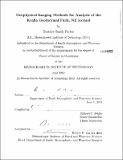| dc.contributor.advisor | Michael C. Fehler. | en_US |
| dc.contributor.author | Parker, Beatrice Smith | en_US |
| dc.contributor.other | Massachusetts Institute of Technology. Dept. of Earth, Atmospheric, and Planetary Sciences. | en_US |
| dc.coverage.spatial | e-ic--- | en_US |
| dc.date.accessioned | 2013-03-13T15:47:20Z | |
| dc.date.available | 2013-03-13T15:47:20Z | |
| dc.date.copyright | 2012 | en_US |
| dc.date.issued | 2012 | en_US |
| dc.identifier.uri | http://hdl.handle.net/1721.1/77790 | |
| dc.description | Thesis (S.M.)--Massachusetts Institute of Technology, Dept. of Earth, Atmospheric, and Planetary Sciences, 2012. | en_US |
| dc.description | Cataloged from PDF version of thesis. | en_US |
| dc.description | Includes bibliographical references (p. 91-94). | en_US |
| dc.description.abstract | Joint geophysical imaging techniques have the potential to be reliable methods for characterizing geothermal sites and reservoirs while reducing drilling and production risks. In this study, we applied a finite difference tomography method and a double-difference tomography method to image the P- and S-wave velocity structure of the Krafla geothermal reservoir in Northeastern Iceland. We combined over 450 new microearthquakes from a network of borehole seismometers from September 2008 and June-July 2011 with over 800 events recorded by surface networks between 2004 and 2008 that were obtained from the Iceland Geosurvey. Starting event locations were determined from the Joint Hypocenter Determination method. Absolute and relative arrival times were used for the two tomographic inversions to jointly invert for event hypocenter locations and velocity structure. Finally, we compared the final velocity structures with a resistivity model determined from a magnetotelluric inversion. Overall, the earthquakes were located in a tight cluster just south of the IDDP well, concentrated into a horizontal layer centered at 2km depth, and oriented in a NW-SE direction by both tomography methods. The main cluster of earthquake locations is at a saddle point of the resistivity model and near regions of low resistivity. Both methods yielded similar overall velocity models, with a locally low velocity region near the surface and a locally high velocity region moving deeper into the model. We have interpreted a high density intrusion, a gas-filled fracture zone, and a possible partial melt region based on the P-wave, S-wave, and Vp/Vs ratio anomalies in the velocity model. Synthetic modeling of the relationship between the resistivity and velocity models demonstrated the complexities of integrating two data sets with signals of different wavelength and resolution. However, with a better understanding of this relationship and knowledge of physical parameters such as porosity, a better constrained joint-inversion of magentotelluric and seismic data will be possible in the future. | en_US |
| dc.description.statementofresponsibility | by Beatrice Smith Parker. | en_US |
| dc.format.extent | 94 p. | en_US |
| dc.language.iso | eng | en_US |
| dc.publisher | Massachusetts Institute of Technology | en_US |
| dc.rights | M.I.T. theses are protected by
copyright. They may be viewed from this source for any purpose, but
reproduction or distribution in any format is prohibited without written
permission. See provided URL for inquiries about permission. | en_US |
| dc.rights.uri | http://dspace.mit.edu/handle/1721.1/7582 | en_US |
| dc.subject | Earth, Atmospheric, and Planetary Sciences. | en_US |
| dc.title | Geophysical imaging methods for analysis of the Krafla Geothermal Field, NE Iceland | en_US |
| dc.type | Thesis | en_US |
| dc.description.degree | S.M. | en_US |
| dc.contributor.department | Massachusetts Institute of Technology. Department of Earth, Atmospheric, and Planetary Sciences | |
| dc.identifier.oclc | 828101229 | en_US |
